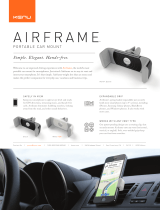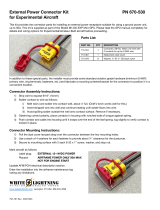PS Engineering
PMA6000B Audio Selector Panel and Intercom System
Installation Manual
200-066-0200 Page ii Rev 6, Feb. 2013
Table of Contents
Section I GENERAL INFORMATION ......................................... 1-1
1.1 INTRODUCTION......................................................................................................................... 1-1
1.2 SCOPE .......................................................................................................................................... 1-1
1.3 EQUIPMENT DESCRIPTION ..................................................................................................... 1-1
1.4 APPROVAL BASIS – FAA & EASA .......................................................................................... 1-2
1.5 SPECIFICATIONS ....................................................................................................................... 1-2
1.6 EQUIPMENT SUPPLIED ............................................................................................................ 1-3
1.7 EQUIPMENT REQUIRED BUT NOT SUPPLIED ..................................................................... 1-3
1.8 LICENSE REQUIREMENTS ....................................................................................................... 1-3
Section II -Installation ...................................................................... 2-1
2.1 GENERAL INFORMATION ....................................................................................................... 2-1
2.1.1 SCOPE ................................................................................................................................. 2-1
2.2 Unpacking and Preliminary Inspection ......................................................................................... 2-1
2.3 Equipment Installation Procedures ................................................................................................ 2-1
2.3.1 Cooling Requirements ......................................................................................................... 2-1
2.3.2 Mounting Requirements ....................................................................................................... 2-2
2.3.3 Mounting Rack Installation .................................................................................................. 2-2
2.3.4 Audio Panel Tray and Connector Assembly ........................................................................ 2-2
2.4 Cable Harness Wiring ................................................................................................................... 2-2
2.4.1 Noise .................................................................................................................................... 2-2
2.4.2 Entertainment Input ............................................................................................................. 2-3
2.4.3 PMA6000B Pin assignments ............................................................................................... 2-4
2.4.4 External Push-to-Talk .......................................................................................................... 2-4
2.4.5 Transmit Interlock ............................................................................................................... 2-5
2.4.6 Power ................................................................................................................................... 2-5
2.4.7 "Swap" Mode ....................................................................................................................... 2-5
2.4.8 Backlighting ......................................................................................................................... 2-5
2.4.9 Middle Marker Sense ........................................................................................................... 2-6
2.4.10 Unswitched Inputs ............................................................................................................... 2-6
2.4.11 Intercom ............................................................................................................................... 2-7
2.5 Adjustments ................................................................................................................................... 2-7
2.6 Marker Antenna Installation .......................................................................................................... 2-7
2.7 Communications Antenna Installation Notes ................................................................................ 2-7
2.8 Unit Installation ............................................................................................................................. 2-8
2.9 Post Installation Checkout ............................................................................................................. 2-8
2.9.1 Required Test Equipment .................................................................................................... 2-8
2.9.2 Power Test ........................................................................................................................... 2-8
2.9.3 Marker Checkout ................................................................................................................. 2-9
2.10 Final Inspection. ....................................................................................................................... 2-9
Section III OPERATION ................................................................ 3-1
3.1 GENERAL INFORMATION ....................................................................................................... 3-1
3.2 Power, Fail Safe Operation (1) ...................................................................................................... 3-1
3.3 Volume Control (2) ....................................................................................................................... 3-2
3.4 Audio Selector (3) ......................................................................................................................... 3-2
3.5 Transmit selection (4) .................................................................................................................... 3-2
3.5.1 Swap Mode (Switch from Com 1 to Com 2 remotely) ......................................................... 3-2
3.5.2 Split Mode ........................................................................................................................... 3-3
3.6 Speaker Amplifier (5) .................................................................................................................... 3-3
3.7 Intercom Operation ....................................................................................................................... 3-3
3.7.1 Adjusting the VOX-Squelch control (6) .............................................................................. 3-3
3.7.2 Intercom Modes (6) ............................................................................................................. 3-3
3.7.3 Entertainment Input ............................................................................................................. 3-4






















